5 Types of Learning Disabilities: A Guide for Teachers

As a teacher, you want all of your students to reach their academic potential. However, not everyone learns at the same pace or in the same way. That means you need to be prepared to provide differentiated aid to students with varying needs, including those with learning disabilities.
What Are Learning Disabilities, Exactly?
Learning disabilities are brain-based disorders that can affect the way students read, write, speak or do math, according to the National Institute of Child Health and Development (NICHD). Dyslexia, a language-based learning disability (LBLD), is one that you've probably heard of.
The National Library of Medicine said learning disabilities impact about 5% of school-aged children globally. That comes out to approximately 1 in every 20 children, meaning you'll likely encounter many students with one of these conditions throughout your career as a teacher.
To ensure that every student in your classroom is making progress, it's essential to familiarize yourself with various disorders, learn to identify them and be prepared to provide individualized support.

"When you understand how students with learning differences process information, you gain a clearer understanding of all students," said Dr. Danny Tanguay, an academic dean of education at Southern New Hampshire University (SNHU).
Tanguay holds a PhD in Educational Leadership and has experience as a teacher, headmaster and education director in New Hampshire school districts. He also held a series of roles at SNHU before accepting his current position.
"When we are prepared to recognize (students') needs and empower their strengths, we help shape confident, capable individuals far beyond the classroom," he said. "Ultimately, it doesn't just help students with learning disabilities; it elevates the entire learning community."
5 Learning Disabilities Teachers Should Know About
Here are a few common conditions that you should be familiar with as a teacher:
 Dyslexia
Dyslexia
Dyslexia accounts for about 80% of all learning disabilities, according to the National Library of Medicine, making it the most frequently observed and diagnosed.
The Learning Disabilities Association of America (LDA) said dyslexia can impact:
- Association of letters with corresponding sounds
- Reading and word recognition
- Spelling
"For children with dyslexia, early intervention and consistent classroom support are crucial," Tanguay said.
Learn more about how to help a child with dyslexia in the classroom.
 Auditory Processing Disorder (APD)
Auditory Processing Disorder (APD)
APD refers to hearing loss that isn't caused by damage to the ear, but rather by issues in how the brain processes sound, according to the Mayo Clinic.
Also referred to as central auditory processing disorder (CAPD), the Mayo Clinic said, symptoms of APD include difficulties with:
- Following complicated directions
- Telling where sounds are coming from
- Understanding speech in a noisy environment
 Non-Verbal Learning Disabilities
Non-Verbal Learning Disabilities
According to LDA, non-verbal learning disabilities affect a student's visual-spatial organization skills, motor skills and social abilities.
LDA notes that other impacts include:
- Ability to perform new tasks
- Coordination
- Executive functioning
 Dyscalculia
Dyscalculia
Dyscalculia is a disorder that affects a student's ability to do math, according to the LDA. Children with dyscalculia may struggle with counting, memorizing sequences and basic math, LDA said, and math anxiety is also common.
 Dysgraphia
Dysgraphia
Dysgraphia affects a student's handwriting, according to the NICHD, and children with this disability may have trouble writing "inside the lines" or in a confined space, forming letters and communicating their thoughts through writing.
How Do You Know If a Child Has a Learning Disability?
"While only certified professionals can formally diagnose a learning disability, teachers are often the first to notice key signs," Tanguay said. "They observe students daily and see patterns that might suggest a child needs further support."
According to Tanguay, some indicators include:
- Consistent academic struggles despite effort
- Communication challenges, like difficulty expressing thoughts, understanding speech or following instructions
- Trouble with organization and time management
- Emotional difficulties
"When a teacher observes signs of a learning disability, it's vital to communicate these observations with parents or guardians and consult the school's special education staff to discuss next steps," Tanguay said.
What Are the Emotional Impacts of Learning Disabilities?
Struggling to do or understand something can be frustrating or embarrassing. This can lead to self-esteem issues, anger problems and other mental health challenges for some students with learning disabilities, according to LDA.
"Teachers should pay attention to social-emotional cues like low self-esteem, frustration or acting out when facing challenges," Tanguay said. "This might look like aggression when the child can't complete a task or has difficulty staying focused and gets easily distracted."
LDA noted that anxiety and depression are especially prevalent for these learners, along with a higher risk for substance abuse later in life.
Find Your Program
How Do You Teach Someone With a Learning Disability?
Teaching someone with a learning disability starts with recognizing that education isn't one-size-fits-all. According to Tanguay, there are approaches that recognize this and help you deliver individualized support — such as Differentiated Instruction and Universal Design for Learning (UDL).
"Differentiated Instruction is a responsive approach where teachers adjust their methods, materials and assessments to meet individual student needs," he said. "Complementing this is UDL, a proactive framework that focuses on designing learning environments to be accessible and engaging for all students from the start."
If you want to learn more, SNHU's Master of Education (MEd) with a concentration in Dyslexia and Language-Based Learning Disabilities (LBLDs) can help. Or, if you aren't quite ready to commit to a full master's program, you could consider a graduate certificate in dyslexia and language-based learning disabilities.
"SNHU’s graduate certificate and MEd concentration equip educators with research-based strategies to support students with language-based learning disabilities, such as dyslexia," said Tanguay.
He said both options include actionable teaching strategies to foster success and boost confidence in the classroom. "Whether you’re an educator, caregiver or advocate, learning how to support students with LBLDs transforms how you see and serve learners," Tanguay said.
Education can change your life. Discover more about SNHU’s graduate certificate in dyslexia and language-based learning disabilities: Find out what courses you'll take, skills you’ll learn and how to request information about the program.
Mars Girolimon '21 '23G is a staff writer at Southern New Hampshire University where they earned their bachelor's and master's, both in English and creative writing. In addition to their work in higher education, Girolimon's short fiction is published in the North American Review, So It Goes by The Kurt Vonnegut Museum & Library, X-R-A-Y and more. Connect with them on LinkedIn.
Explore more content like this article

What is a Minor in College?

Top Careers With a Master’s Degree

How to Get Involved as an Online Student
About Southern New Hampshire University

SNHU is a nonprofit, accredited university with a mission to make high-quality education more accessible and affordable for everyone.
Founded in 1932, and online since 1995, we’ve helped countless students reach their goals with flexible, career-focused programs. Our 300-acre campus in Manchester, NH is home to over 3,000 students, and we serve over 135,000 students online. Visit our about SNHU page to learn more about our mission, accreditations, leadership team, national recognitions and awards.


